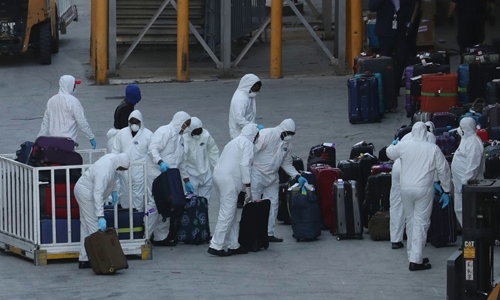The world recorded more than one million nCoV infections and nearly 53,000 deaths as data in the US and Europe continued to grow rapidly.
According to statistics from John Hopskin University, the world currently records 1,011,490 cases and 52,863 deaths from nCoV in 204 countries and territories, up 77,902 and 5,994 respectively compared to yesterday. 210,186 people have recovered, mostly in China.

Workers in protective clothing check on luggage from Dutch yacht Zaadam after it docked in Florida, USA on April 2. Photo: AFP
Data show that deaths from nCoV globally have doubled since March 27. Europe is currently the epidemic center with 542,191 cases and 37,715 deaths, equivalent to 54% and 73% globally, according to AFP. By March 7, the number of infections in Europe was less than 10,000.
The sharp increase in the number of synonymous synonyms is spreading at an alarming rate.
The situation in the US, the largest epidemic region in the world, is even more alarming. The world's largest economy reported an additional 28,295 cases and 781 deaths in the past 24 hours, bringing the number of infections and deaths to 243,298 and 5,883 respectively. The US recorded its first death on March 1, but by April 2, the number was closer to 6,000, showing that the number of deaths caused by nCoV in the US doubled every three days.
The US urgently needs medical supplies and equipment to cope with the epidemic and may stop providing medical supplies to allied countries. Many states are urgently asking the government to support masks, ventilators and protective gear to cope with the wave of patients rushing to hospitals. President Donald Trump said the government was holding close to 10,000 ventilators because "the upcoming outbreak was very strong" and ready to distribute.
Italy recorded 4,668 more cases and 760 deaths, bringing the number of infections and deaths to 115,242 and 13,915, continuing to be the deadliest epidemic zone in the world.
However, two new studies have shown that the actual death toll in Italy is much higher than reported. According to data analysis firm InTwig, in the area around the city of Bergamo, which was most affected by Covid-19, about 4,500 people died in March, but only 2,060 people were counted.
Another problem is that Italy recorded a much lower number of nCoV infections. The country has so far reported nearly 111,000 people with nCoV infection, but they have tested only for those with symptoms. Health and government officials estimate the actual number of people infected with nCoV in the country could be in the hundreds, even to 6 million.
Spain confirmed 112,065 people infected and 10,348 deaths due to nCoV after an additional 7,947 infections and 961 deaths. This is the largest increase in daily deaths ever recorded since the outbreak in Spain.
However, the new infection rate in Spain is the lowest ever recorded, suggesting that the blockade appears to be effective in preventing the virus from spreading. "The data shows that the curve has stabilized," and the epidemic has entered a "slowing" stage, Health Minister Salvador Illa said.
Spain imposed a nationwide blockade order from March 14 to April 11 to limit the spread of the virus, despite the severe economic impact. The Spanish Ministry of Labor said it received more than 300,000 new jobless claims in March, the highest monthly increase ever recorded.
Germany is still the third largest epidemic area in Europe with 6,813 cases and 176 deaths recorded, bringing the number of cases and deaths to 84,794 and 1,107 respectively. The death rate in Germany is quite low, at only 1.3%, apparently due to a wide-ranging testing strategy. Germany also has special care beds, and state-paid health care.
The German government has ordered the closure of most shops and schools and imposed a ban on gathering more than two people at least until April 19. Germany has also received over 100 Covid-19 patients in serious condition from European Union (EU) countries.
He reported an additional 4,244 cases and 569 deaths, the largest daily increase ever recorded in the country, bringing the number of cases and deaths to 33,718 and 2,921, respectively.
British Prime Minister Boris Johnson, who is quarantining himself at home with nCov infection, yesterday announced he would "increase testing", while the Health Minister set a goal to perform 100,000 tests a day for two weeks. The British government has been criticized earlier for not conducting extensive testing, especially for frontline health workers. Officials revealed that only 2,000 of the 500,000 British health workers were tested for nCoV.
Iran continues to be the second largest epidemic region in Asia, after China, with 50,468 cases and 3,160 deaths.
Iranian President Hassan Rouhani warned at a cabinet meeting yesterday that Covid-19 could last for months, even through the end of the year. According to the Persian calendar, this year's Iran will end in March 2021. Rouhani also said that Iran could implement more restrictive measures to prevent Covid-19.
Many senior Iranian officials have been infected and the latest case is Parliamentary Ali Larijani, 62. He is currently isolated and treated.
China and South Korea have not announced new cases. China since 1/4 has begun to include asymptomatic nCoV cases in daily statistics. Asymptomatic nCoV infections will also be concentrated in isolation for 14 days.
In Southeast Asia, Malaysia continues to be the largest epidemic area with 3,116 cases and 208 deaths. The World Health Organization (WHO) predicts that Covid-19 in Malaysia will peak in mid-April, while the number of critical illnesses is expected to peak next week.
The Philippines reported 2,633 infections and 107 deaths. Thailand recorded 1,875 cases, of which 15 died, compared with 1,790 and 170 in Indonesia, respectively. The World Bank warned the disease could cause 11 million people in Asia - The Pacific will be poor without intervention and the region may face the worst economic downturn in 20 years.



 PaulHopp
PaulHopp







